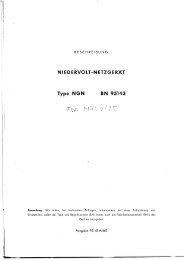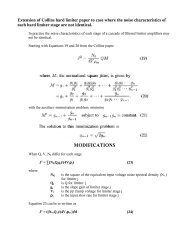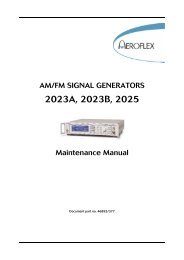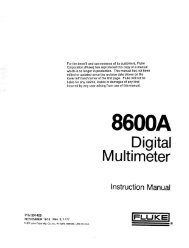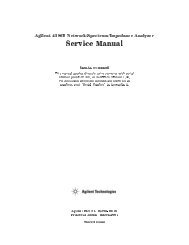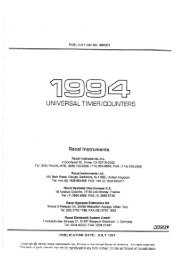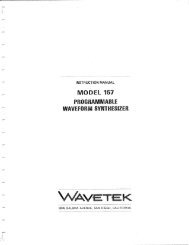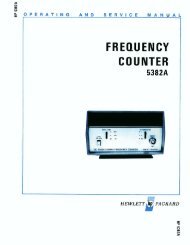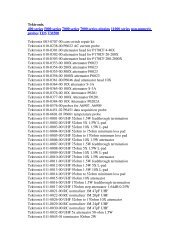TM 11-6625-2837-14&P-7 TECHNICAL MANUAL OPERATOR'S ...
TM 11-6625-2837-14&P-7 TECHNICAL MANUAL OPERATOR'S ...
TM 11-6625-2837-14&P-7 TECHNICAL MANUAL OPERATOR'S ...
Create successful ePaper yourself
Turn your PDF publications into a flip-book with our unique Google optimized e-Paper software.
SERVICE SHEET 7<br />
<strong>TM</strong> <strong>11</strong>-<strong>6625</strong>-<strong>2837</strong>-14 & P-7<br />
NOTE<br />
When a malfunction occurs, refer to Section VIII of the Model 8660-series mainframe manual to begin<br />
troubleshooting (Systems Troubleshooting Guide). If the information then indicates possible problems in the RF<br />
Section, refer to the Systems Troubleshooting information Service Sheet 1 in this manual. This information may be<br />
used to isolate the defect to the RF Section, another plug-in, or the mainframe. If the problem is in this plug-in, refer<br />
to Service Sheet 2 for further troubleshooting information .<br />
PRINCIPLES OF OPERATION<br />
General<br />
The detected signal output from the A4 Detector Amplifier Assembly is coupled into the A3 ALC Amplifier Assembly where it is<br />
compared to the reference input. Any difference in dc input levels causes an error output signal (i.e., a change from the loop quiescent<br />
state) at the difference amplifier output A3TP1. The error signal is coupled through the Gain-Shaping Amplifier to the A5 Modulator<br />
Assembly which controls the RF output level. The change in RF output level is reflected in a dc level change at the input to the dc<br />
amplifier. The change serves to balance the original error output signal at A3TP1.<br />
A10 Reference Assembly<br />
The Reference Assembly output is coupled to the ALC circuit where it is compared to the Detector Amplifier output. An error signal is<br />
generated which causes the RF signal to follow the reference dc level or, in AM mode, a low frequency ac signal which is<br />
superimposed on the reference dc output.<br />
A reference dc level is established by A1OVR1. This dc level is coupled to the inverting input of AlOUl where (in the +10 dBm range<br />
only) a small RF Detector diode linearity compensation current is added from the 10H input through resistor AlOR14. The output of<br />
AlOUl passes through a remotely controlled attenuator or an adjustable voltage divider which includes R1 VERNIER Control. This<br />
provides fine adjustment of the reference output, i.e., the RF Output level over a 10 dB range.<br />
The Amplitude Modulation drive signal is input at the non-inverting input of A1OU1. The AM Gain input is a dc compensation signal<br />
which effects the level of the AM drive input. As the VERNIER control is rotated cw, the dc level goes more negative which increases<br />
the RF Output level. At the same time a negative change of the AM Gain compensation increases the modulation drive signal<br />
attenuation of the AM drive signal input to A10U1. The resulting increase in modulation drive signal at the output of AlOUl tends to<br />
keep the percentage modulation level constant with change in RF output level.<br />
In the remote mode, the front panel VERNIER control of the RF output level is inhibited and the 1 dB step attenuator assumes<br />
"vernier" control over<br />
8-28


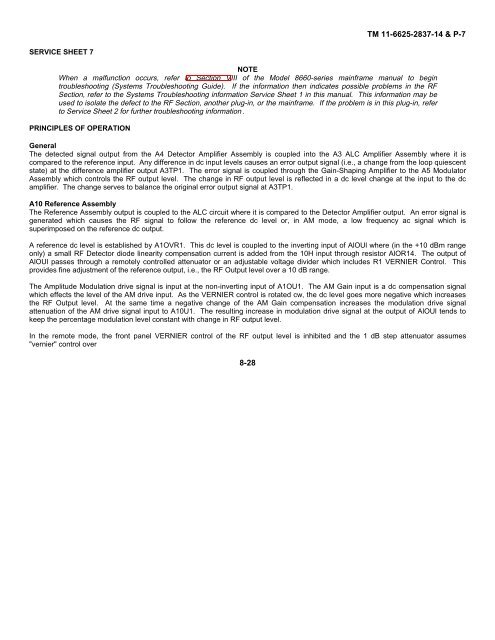
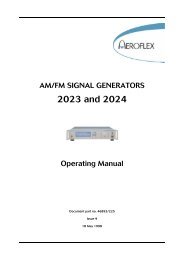
![[6]](https://img.yumpu.com/23901941/1/184x260/6.jpg?quality=85)

